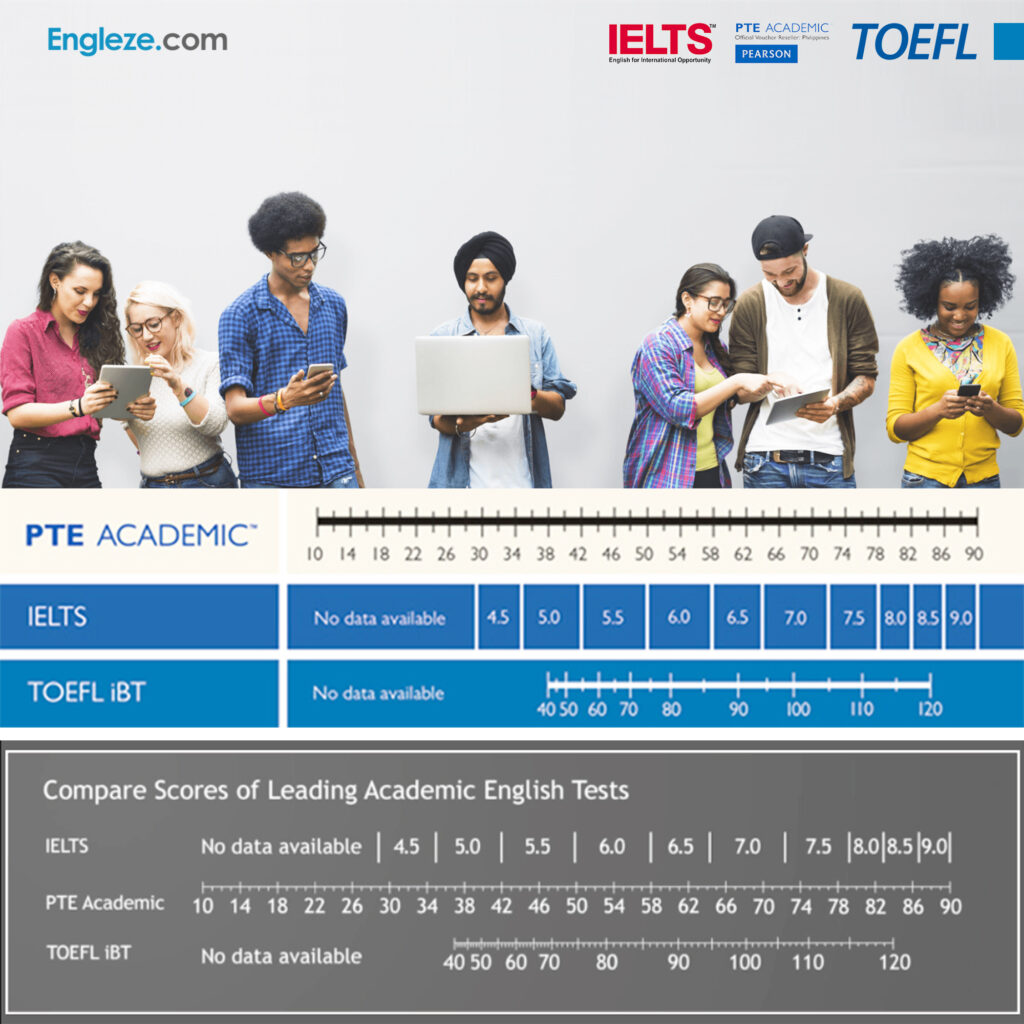In 2017, there are three major English language proficiency exams that MBA and other programs use to test an applicant’s ability to speak in English. In the past, the Test of English as a Foreign Language (TOEFL) and the International English Language Testing System (IELTS) were the most common.
In 2009, Pearson–one of the most prominent educational companies and publishing houses in the US–launched its own Proficiency Exam: the Pearson Test of English, Academic (PTE Academic).
These three tests claim to deliver equatable results (see chart below); yet, not every MBA program, for example, accepts all three exams. In general, the IELTS is more accepted in Europe and Australia while the TOEFL is much more commonly accepted by MBA programs in the US. The PTE Academic, though the newest of the three, is making good headway into being accepted by MBA programs all over the world.

Institution Requirements
It is recommended that you check with the schools you are applying to in order to see which test they accept. Generally, the IELTS is more readily accepted in universities within the Commonwealth although many US universities are starting to accept it too. The US tends to prefer the TOEFL with over 8,000 universities that accept it. Ultimately you will need to take the corresponding exam to that which your schools require, although many now accept both.
Because not every MBA program accepts all three tests, be sure you take the necessary exam for each program you apply to. This might mean you have to take two of these tests: The IELTS for one program and the TOEFL for another. Since the PTE Academic is the newest of the exams, most schools that accept it also accept one of the other two exams.
If you are lucky enough to apply to a program that accepts more than one of these exams, you might want to think about which exam suits your testing style best. For example, the Speaking section of each test is very different. And since this language skill is often the most difficult for test-takers to master, you might want to consider which test’s Speaking section is best suited to your strengths.
Test Availability
Is the TOEFL or IELTS available to closer to you? The TOEFL is available in 4,500 centers in 165 countries, whereas the IELTS exam is available in 1,100 centers across 140 countries. The newer PTE is only available in 250 testing centers in 50 countries. It may also be the case that one test has more convenient test dates available for you.
Test Differences
Test section differences between TOEFL and IELTS are another factor to consider, as whether or not an exam plays to your strengths will greatly impact the maximum score you can achieve. Here are the main differences between the TOEFL and IELTS exams that students usually find play to/against their strengths:
* ANSWER FORMATS
The Reading and Listening sections of both exams will require you to answer series of questions with short answers or to create an ordered list of stages or event items. The TOEFL is comprised of mainly multiple choice “drag and drop” questions and those that are not (such as the list/ stage questions) will have the question items displayed. The IELTS however, will require you to come up with the answer to many of the questions in these sections yourself. So if the Reading and Listening test sections are areas that you find difficult, the TOEFL may be slightly less challenging.
* LISTENING SECTION SAMPLES
The TOEFL Listening section is based on a classroom/lecture environment playing discussions by teachers and students, whereas the IELTS Listening section has more conversation based samples or a speech by one person. Some students find the TOEFL more challenging in this area due to the use of expressions, slang, ideas etc. in the discussions, which require more concentration. So if the Listening section is a test area you find more challenging, you may find the IELTS less intimidating.
* READING PASSAGES
The reading section in both exams bases several questions on each passage given. The main difference is the type of texts used. The IELTS uses a mixture of academic texts and passages from news articles, whereas the TOEFL uses only academic passages, which can use more challenging vocabulary and are often slightly longer. If you are not confident in your reading skills, you may therefore prefer the IELTS exam.
* RECORDED SPEAKING VS. ORAL INTERVIEW
A section that most test takers find the most daunting is the speaking section. The TOEFL and PTE speaking sections (just like the rest of the test) are administered on the computer, you will hear a recorded question and then give your response into a microphone, which will then be recorded and submitted for review. However, the TOEFL speaking section is evaluated by a human rater, while the PTE speaking section is evaluated by a computer program.
The IELTS however is conversation based – a live interview with an examiner. This really will depend on your own preference. Whether you would find a live conversation more natural or you would better remember your preparation without the distraction of another person.
The TOEFL exam therefore all takes place on one day, whereas due to the IELTS’ format this section is taken separately from the rest of the exam, sometimes on a different day before or after. Some students prefer this as they can focus their preparation better. However, some prefer to get the whole exam over with in one sitting.
Engleze.com






